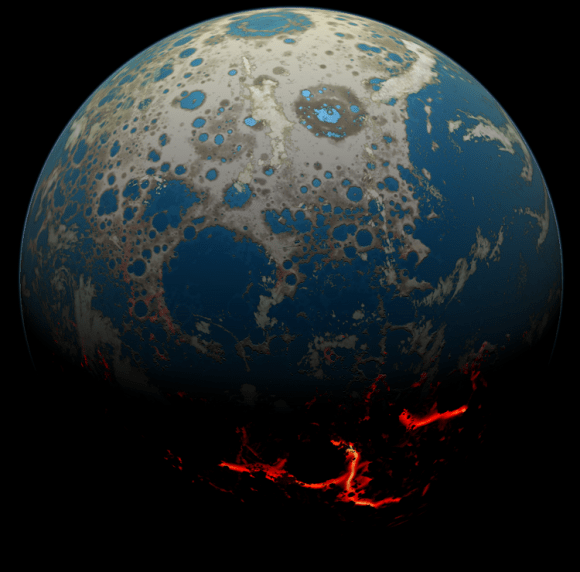In case you need a reminder that the solar system was a harsh place to grow up, the early Earth looks like it was in the middle of a shooting gallery in this model. The map that you see above shows a scenario for where researchers believe asteroids struck our planet about four billion to 4.5 billion years ago, which is very early in the Earth’s five-billion-year history.
The research reveals the surface of the Earth repeatedly being churned by these impacts as the young solar system came together, with small rocks gradually coalescing into planetesimals. Much of the leftover debris peppered the planets, including our own.
“Prior to approximately four billion years ago, no large region of Earth’s surface could have survived untouched by impacts and their effects,” stated Simone Marchi, who led the research and works at the Southwest Research Institute in Colorado.
“The new picture of the Hadean Earth emerging from this work has important implications for its habitability,” added Marchi, who is also senior researcher at NASA’s Solar System Exploration Research Virtual Institute.
In this dangerous early period, the researchers estimate the Earth was smacked by 1-4 asteroids or comets that were more than 600 miles (966 kilometers) wide — enough to wipe out life across the planet. They also believe that between 3-7 impactors were more than 300 miles (482 kilometers) wide, which would evaporate oceans across the world.

“During that time, the lag between major collisions was long enough to allow intervals of more clement conditions, at least on a local scale,” added Marchi. “Any life emerging during the Hadean eon likely needed to be resistant to high temperatures, and could have survived such a violent period in Earth’s history by thriving in niches deep underground or in the ocean’s crust.”
To produce the model, the researchers took a recent model of lunar impacts and applied it to Earth. The moon’s scarred surface helps them estimate what happened on our own planet, they said, because the craters provide an “absolute impactor flux” separate from any models that talk about how the Earth came together. Recall that erosion on the moon is very slow, providing accessible records of things that happened millions or billions of years ago.
The research was published in the journal Nature.
Source: NASA


This is consistent with earlier work that has both the early Earth and Mars crust with water on average (< 100 degC) albeit early Mars had but 1/5 the habitable surface. The models show that prokaryotes proliferate and recolonize areas faster than the impact flows sterilize.
Interestingly re the 3-7 ocean evaporators here, in Abramov et al models the first they used predicted no ocean evaporator but the last one (even with the lower impact mass flux of the recent Nice 2 model) has a 50 % likelihood of one such.
["The impact environment of the Hadean Earth", Abramov et al, Chemie der Erde 2013; "THERMAL EFFECTS OF IMPACT BOMBARDMENTS ON EARLY MARS." O. Abramov et al, Eighth International Conference on Mars (2014) http://www.hou.usra.edu/meetings/8thmars2014/pdf/1484.pdf ]
With the same impact flows, if the late bombardment spike ending the Hadean was survivable, earliest life could appear at least 4.35 billion years ago.
Re the hot impact material burial of crust of these models, one has to remember that arguably but simpler plate tectonics predict the same effect of crust extinction. The oldest rocks arguably dates from 4.2 billion years ago. They contain material that show that the earliest continental crust formed 4.0 billion years ago, it is unlikely to have earlier such due to the extraordinary geology of the find. [ http://www.nature.com/ngeo/journal/v7/n7/full/ngeo2170.html ]
But if earlier crust, such as the oldest 4.2 billion year old material that embeds the 4.0 billion year old, is ocean crust it has a lifetime of 100 million years on average today, and perhaps less on the hot early Earth. Meaning the 4.2 old material is about as old we can expect to find, the rest was reworked whether buried in lava or not.
“…took a recent model of lunar impacts and applied it to Earth.” So the above animation shows an approximation of what happened to the Earth and is not based on known or actual impacts. I thought the map might have been generated by mass-cons as seen with recent gravitational mapping? Instead, as mentioned, it’s just an estimate, eh? Still, that’s quite the ‘splatter pattern’!
Won’t somebody please invent a time machine so we can see the real deal? All we’d have to do, is be instantaneously transported some 4-4.5 billion light years out with a VERY LARGE telescope and look back? ~LOL~
Weren’t the early oceans greenish instead of blue, as shown in “Artist’s conception of early Earth?”
Artists’ conceptions of Earth were mostly green until Apollo 8 took that famous picture 🙂